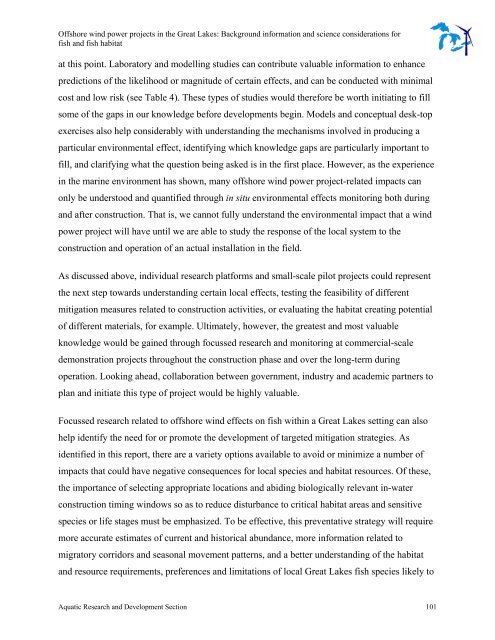Offshore Wind Power Projects in the Great Lakes - Ministry of ...
Offshore Wind Power Projects in the Great Lakes - Ministry of ...
Offshore Wind Power Projects in the Great Lakes - Ministry of ...
You also want an ePaper? Increase the reach of your titles
YUMPU automatically turns print PDFs into web optimized ePapers that Google loves.
<strong>Offshore</strong> w<strong>in</strong>d power projects <strong>in</strong> <strong>the</strong> <strong>Great</strong> <strong>Lakes</strong>: Background <strong>in</strong>formation and science considerations for<br />
fish and fish habitat<br />
at this po<strong>in</strong>t. Laboratory and modell<strong>in</strong>g studies can contribute valuable <strong>in</strong>formation to enhance<br />
predictions <strong>of</strong> <strong>the</strong> likelihood or magnitude <strong>of</strong> certa<strong>in</strong> effects, and can be conducted with m<strong>in</strong>imal<br />
cost and low risk (see Table 4). These types <strong>of</strong> studies would <strong>the</strong>refore be worth <strong>in</strong>itiat<strong>in</strong>g to fill<br />
some <strong>of</strong> <strong>the</strong> gaps <strong>in</strong> our knowledge before developments beg<strong>in</strong>. Models and conceptual desk-top<br />
exercises also help considerably with understand<strong>in</strong>g <strong>the</strong> mechanisms <strong>in</strong>volved <strong>in</strong> produc<strong>in</strong>g a<br />
particular environmental effect, identify<strong>in</strong>g which knowledge gaps are particularly important to<br />
fill, and clarify<strong>in</strong>g what <strong>the</strong> question be<strong>in</strong>g asked is <strong>in</strong> <strong>the</strong> first place. However, as <strong>the</strong> experience<br />
<strong>in</strong> <strong>the</strong> mar<strong>in</strong>e environment has shown, many <strong>of</strong>fshore w<strong>in</strong>d power project-related impacts can<br />
only be understood and quantified through <strong>in</strong> situ environmental effects monitor<strong>in</strong>g both dur<strong>in</strong>g<br />
and after construction. That is, we cannot fully understand <strong>the</strong> environmental impact that a w<strong>in</strong>d<br />
power project will have until we are able to study <strong>the</strong> response <strong>of</strong> <strong>the</strong> local system to <strong>the</strong><br />
construction and operation <strong>of</strong> an actual <strong>in</strong>stallation <strong>in</strong> <strong>the</strong> field.<br />
As discussed above, <strong>in</strong>dividual research platforms and small-scale pilot projects could represent<br />
<strong>the</strong> next step towards understand<strong>in</strong>g certa<strong>in</strong> local effects, test<strong>in</strong>g <strong>the</strong> feasibility <strong>of</strong> different<br />
mitigation measures related to construction activities, or evaluat<strong>in</strong>g <strong>the</strong> habitat creat<strong>in</strong>g potential<br />
<strong>of</strong> different materials, for example. Ultimately, however, <strong>the</strong> greatest and most valuable<br />
knowledge would be ga<strong>in</strong>ed through focussed research and monitor<strong>in</strong>g at commercial-scale<br />
demonstration projects throughout <strong>the</strong> construction phase and over <strong>the</strong> long-term dur<strong>in</strong>g<br />
operation. Look<strong>in</strong>g ahead, collaboration between government, <strong>in</strong>dustry and academic partners to<br />
plan and <strong>in</strong>itiate this type <strong>of</strong> project would be highly valuable.<br />
Focussed research related to <strong>of</strong>fshore w<strong>in</strong>d effects on fish with<strong>in</strong> a <strong>Great</strong> <strong>Lakes</strong> sett<strong>in</strong>g can also<br />
help identify <strong>the</strong> need for or promote <strong>the</strong> development <strong>of</strong> targeted mitigation strategies. As<br />
identified <strong>in</strong> this report, <strong>the</strong>re are a variety options available to avoid or m<strong>in</strong>imize a number <strong>of</strong><br />
impacts that could have negative consequences for local species and habitat resources. Of <strong>the</strong>se,<br />
<strong>the</strong> importance <strong>of</strong> select<strong>in</strong>g appropriate locations and abid<strong>in</strong>g biologically relevant <strong>in</strong>-water<br />
construction tim<strong>in</strong>g w<strong>in</strong>dows so as to reduce disturbance to critical habitat areas and sensitive<br />
species or life stages must be emphasized. To be effective, this preventative strategy will require<br />
more accurate estimates <strong>of</strong> current and historical abundance, more <strong>in</strong>formation related to<br />
migratory corridors and seasonal movement patterns, and a better understand<strong>in</strong>g <strong>of</strong> <strong>the</strong> habitat<br />
and resource requirements, preferences and limitations <strong>of</strong> local <strong>Great</strong> <strong>Lakes</strong> fish species likely to<br />
Aquatic Research and Development Section 101
















